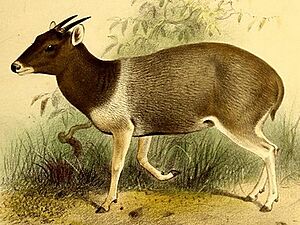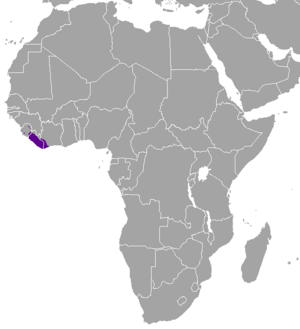Jentink's duiker facts for kids
Quick facts for kids Jentink's duiker |
|
|---|---|
 |
|
| Conservation status | |
| Scientific classification | |
 |
|
| Distribution of Jentink's duiker |
The Jentink's duiker (Cephalophus jentinki) is a shy, forest-dwelling animal. People in Sierra Leone call it gidi-gidi or kaikulowulei. This unique creature lives in the southern parts of Liberia, southwestern Côte d'Ivoire, and some scattered areas in Sierra Leone. It was named after a person called Fredericus Anna Jentink.
Jentink's duikers are quite large for a duiker. They stand about 80 cm (31 in) tall at the shoulder. They can weigh around 70 kg (150 lb). This makes them the biggest type of duiker. Their fur is very striking. It's dark black on the front half of their body. The back half, from their shoulders, is gray. A bright white band crosses their shoulders. This band connects the two colors and joins their white belly. Jentink's duikers also have long, thin horns. These horns curl back a little at the ends. They can grow between 14 and 21 cm (5.5 and 8.3 in) long.
Contents
Where Jentink's Duikers Live and What They Eat
Jentink's duikers mostly live in very thick rainforests. They like places where the trees are dense. They are nocturnal, which means they are active at night. During the day, they hide in thick bushes or among tree roots. They seem to live in pairs.
These duikers eat many different things. They enjoy fruits, flowers, and leaves that have fallen from the tall trees. They also munch on young plant stems and roots. Sometimes, they eat palm nuts, mangos, and cocoa pods. This can be a problem for local farmers. Jentink's duikers are said to be territorial. This means they protect their living space. If they get scared, they run very fast. However, they get tired easily.
Discovery and History of Jentink's Duiker
Scientists first realized this animal was a new species in 1884. But it wasn't officially described until 1892. After that, the species seemed to disappear for a while. A skull was found in Liberia in 1948, which confirmed its existence. People started seeing them in their natural homes again in the 1960s. In 1971, the Gladys Porter Zoo successfully bred Jentink's duikers. This was a big step in learning more about them.
Why Jentink's Duikers Need Our Help
We don't have exact numbers for how many Jentink's duikers are left today. In 1999, experts thought there were about 3,500 in the wild. But just a year later, others suggested there might be fewer than 2,000. This means they are an endangered species.
The biggest threats to Jentink's duikers are two things. One is habitat destruction. This happens when their forest homes are cut down or changed. The other threat is hunting. People hunt them for bushmeat, which is meat from wild animals. Protecting their forests and stopping illegal hunting are very important to help these duikers survive.
Understanding Jentink's Duiker's Family Tree
Scientists group living things into categories. This helps us understand how they are related. The Jentink's duiker belongs to the genus Cephalophus. It is part of the Bovidae family. This family includes animals like cows, goats, and antelopes.
The name "duiker" comes from an Afrikaans word. It means "diver." This is because duikers often dive into thick bushes when they are scared. The British zoologist Oldfield Thomas first described the Jentink's duiker in 1892. He wrote about it in a scientific paper.
Scientists use special studies to figure out how animals are related. They look at things like DNA. These studies show that Jentink's duiker is closely related to other "giant duikers." These include the yellow-backed duiker and the bay duiker. They also found that the zebra duiker is a close relative. Scientists believe that Jentink's duiker and the bay duiker developed into separate species less than 2.5 million years ago.
|
||||||||||||||||||||||||||||||||||||
| How Jentink's duiker is related to other duikers (Johnston et.al. 2012) |


